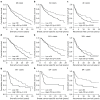High Cell-Free DNA Integrity Is Associated with Poor Breast Cancer Survival
- PMID: 34572906
- PMCID: PMC8467852
- DOI: 10.3390/cancers13184679
High Cell-Free DNA Integrity Is Associated with Poor Breast Cancer Survival
Abstract
Background: A recent point of focus in breast cancer (BC) research has been the utilization of cell-free DNA (cfDNA) and its concentration (cfDConc) and integrity (cfDI) as potential biomarkers. Though the association of cfDConc and poor survival is already recognized, studies on the prognostic value of cfDI have had contradictory results. Here, we provide further evidence to support the use of cfDI as a potential biomarker.
Methods: We selected 204 Eastern Finnish BC cases with non-metastatic disease and isolated cfDNA from the serum collected at the time of diagnosis before any treatment was given. The cfDConc and cfDI were measured with a fluorometer and electrophoresis and analyzed with 25 years of survival data.
Results: High cfDConc was not an independent prognostic factor in our analyses while high cfDI was found to be an independent prognostic factor for poor OS (p = 0.020, hazard ratio (HR) = 1.57, 95% confidence interval (CI) 1.07-2.29, Cox) and BCSS (p = 0.006, HR = 1.93, 95% CI 1.21-3.08)). Inclusion of cfDI in the multivariate logistic regression model improved the predictive performance.
Conclusions: Our results show high cfDI is an independent prognostic factor for poor OS and BCSS and improves the predictive performance of logistic regression models, thus supporting its prognostic potential.
Keywords: DNA fragmentation; biomarker; diagnostics; liquid biopsy.
Conflict of interest statement
The authors declare no conflict of interest. The funders had no role in the design of the study; in the collection, analyses, or interpretation of data; in the writing of the manuscript, or in the decision to publish the results.
Figures





References
-
- Allemani C., Matsuda T., Di Carlo V., Harewood R., Matz M., Nikšić M., Bonaventure A., Valkov M., Johnson C.J., Estève J., et al. Global surveillance of trends in cancer survival 2000–2014 (CONCORD-3): Analysis of individual records for 37,513,025 patients diagnosed with one of 18 cancers from 322 population-based registries in 71 countries. Lancet. 2018;391:1023–1075. doi: 10.1016/S0140-6736(17)33326-3. - DOI - PMC - PubMed
Grants and funding
LinkOut - more resources
Full Text Sources

